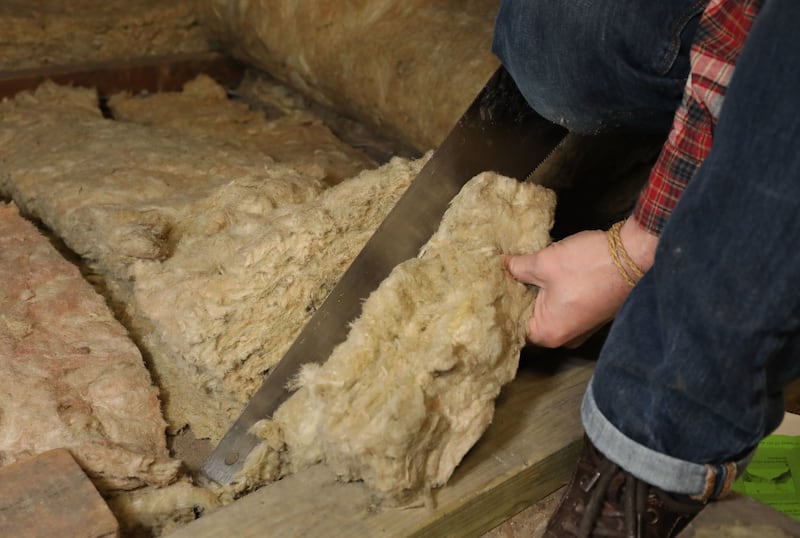Thinking of retrofitting your home? Having a B building energy rating (Ber) or better is unlocking a growing list of discounts. Households with a decent rating are spending less on energy bills, getting cheaper mortgage rates, discounts on home insurance and a better return should they rent or sell their home. When weighing up the cost of a retrofit, here are some of the discounts, and costs, to consider.
Cheaper bills
The better your home’s Ber, the less energy it requires to keep heated. This means lower bills. Attic insulation, wall insulation, new windows, doors or a new heating system are going to cost – are your energy bills really going to be that much cheaper?
If you want to compare the running cost of your home with that of a B2-rated home – the minimum that the Sustainable Energy Authority of Ireland (SEAI) recommends you aim for when upgrading an older home – it provides a useful calculator.
Take for example a family of four, living in a semi-d with heating from a gas boiler. The home is D-rated and, in winter, the heat is on from 6am to 8am and again from 6pm to 10pm. The thermostat is at 20 degrees.
READ MORE
On the other side of the wall, the neighbours have some work done, including installing a heat pump and demand control ventilation. Their house, which is exactly the same size, is now a B2 rating – are they really saving that much money?
Even though the houses are the same size, the neighbours are using about 60 per cent less energy and their bills will be about 17 per cent less, according to SEAI estimates. They are using renewable energy, which is cheaper.
The D-rated home’s estimated energy bill for the year is €2,100, the bill for the B2 rated home is €1,750. That’s a saving of €350 a year. Over time these savings will go some way towards paying back the cost of works.
There’s the comfort factor too. Households with a higher energy rating end up paying less money for more comfort. After the heat is switched off, a B2-rated home stays warmer for longer.
What about someone living in an oil-fired 1970s bungalow? They are using 56 per cent more energy than the B-rated home and spending 30 per cent, or €650 more on their energy bills.
Those new A-rated homes on the edge of town – they are paying least of all. Comparing a B2-rated home with one that has an A-rating translates into a further saving of 24 per cent in annual energy bills, according to estimates by builder Glenveagh.
More valuable home
Spending money on insulation and a new heating system can increase the value of your home. Its value increases by 1 per cent for every level you go up on the building energy rating scale, according to the SEAI.
For example, a home that goes from a Ber of G to a B2 rating will increase its value by 10 per cent. That means you will get some of the money spent on energy upgrades back should you sell.
If your home is a D2-rating and you upgrade to the SEAI-recommended B2-rating, that’s an increase of six grades on the Ber scale, and a 6 per cent increase in the value.
Searches by energy rating on myhome.ie climbed by more than 35 per cent in the first two months of 2023 compared with the last two months of 2022, according to research by the website. Energy prices and concerns about sustainability meant three-quarters of house-hunters were more inclined to consider a property’s Ber in their decision-making.
Take two identical houses built in 2002 in Delgany Wood, Co Wicklow, recently marketed for sale. One has its original D1 energy rating, the other is four rungs up the scale at B3. Both have the same layout and aspect, however the one with the higher energy rating and more energy efficient windows, doors and insulation was marketed for €10,000 more.
The selling price difference can be justified because the new owners could qualify for a cheaper mortgage rate and the home will have lower heating bills too.
The seller, who got to enjoy a more comfortable home and lower bills for some years before selling, will also get a return on their investment through its sale.
[ Buyers of older homes may pay thousands more per year in mortgage repaymentsOpens in new window ]
Mortgage discount
The big banks are determined to cash in on green and are offering discounted mortgage rates on homes that have good energy ratings. Green mortgage rates are generally available if your building energy rating is from A1 to B3.
Take a mortgage holder whose home has a D1 energy rating. The home is worth €600,000, and there is €200,000 and 20 years remaining on the mortgage. They are on a 3.78 per cent four-year fix with Avant, with a mortgage repayment of €1,172 a month.
As they plan to remain in their home in the medium term, they decide to invest in retrofit measures, bringing their home up to a B3 energy rating. This higher rating unlocks green mortgage rates with the likes of Haven, AIB and PTSB, reserved for homes rated B3 or better.
By switching to a Green four-year fixed rate with Haven, for example, repayments drop by €18 a month or €216 a year, with €3,000 towards legal costs. It’s not a big saving, but having a better Ber widens your switching options.
Things are slightly better for house movers. Those borrowing €300,000 over 25 years to buy a B2-rated home can avail of AIB’s Green Five Year Fix rate of 3.6 per cent with repayments of €1,493 a month. Borrow for a D1-rated home and the best available rate is 3.78 per cent with Avant, where repayments are €25 more per month.
Lower home insurance
Having a good building energy rating can also mean cheaper home insurance. Good insulation can reduce the risk of burst pipes due to freezing temperatures. Upgrading heating, plumbing and electrics can make your home safer too. If your home has a Ber rating of A or B, you can save 5 per cent on your home insurance with Zurich, for example. If your Ber has improved, ask your insurer if they offer a discount when you next renew.

Can I afford it?
Cost is one of the biggest barriers to retrofitting, according to surveys by the SEAI. Of 223 semi-detached and mid-terrace homes retrofitted last year using the SEAI’s one-stop-shop service, the median cost of works was €59,300. Grants of €22,000 brought that down to €37,800. Homes went from an average building energy rating of E1 to A2.
The cost of getting to an A-rating will be prohibitive for many, but you don’t have to approach it this way. Picking off a few lower-cost, high-impact measures will get many houses to a B rating. This can be enough to make your home noticeably more comfortable, to lower your bills and unlock discounts.
Homeowners who went this Better Energy Homes scheme route last year, which means hiring an SEAI-registered provider to do a few individual high-impact upgrades, got a median of €7,300 worth of upgrades done, but it cost them just €3,100 after grants. That’s according to the SEAI’s National Retrofit Plan report for 2023.
For example, the median cost for roof insulation was €2,125 but an SEAI grant covered €1,400 of that. Heat rises and up to 30 per cent of your home’s heat can be lost through your roof. The payback from attic insulation is instantaneous. It’s one of the cheapest, but highest impact measures households can do.
The median cost of cavity wall insulation was €2,000 with a grant of €1,700. The median cost of internal wall insulation was €8,000 with a grant covering €3,500 of that.
First step
Getting to at least a B-rating will unlock discounts. The first step is to find out what measures you need to do to get there, and how much it will cost with grants.
Get a Ber assessor who can do an assessment to the standard of the SEAI’s one-stop-shop service, says Conor Walsh of SEAI-registered provider Encon. Call a few providers to get quotes. There’s a grant of €350 for the assessment.
This assessment will give you a detailed technical report and a roadmap of the upgrades needed to bring your house to maximum efficiency, along with an estimate of how much it will all cost. You don’t have to carry out the work to get the grant for the assessment. From the report, you can cherry-pick what will bring the biggest bang for your buck.
Borrow to save?
A new low-cost energy upgrade loan scheme, arranged by the Strategic Banking Corporation of Ireland, is designed to make it more affordable for homeowners to undertake an energy upgrade.
Homeowners can borrow €5,000-€75,000 over a term of up to 10 years, with interest rates starting from 3 per cent, from PTSB, AIB and Bank of Ireland to make their homes warmer and cheaper to run. Homeowners who borrow €30,000 over 10 years on a 3 per cent variable rate with Bank of Ireland will have monthly repayments of €289.
Upgrades must be supported by an SEAI grant and be projected to achieve a minimum 20 per cent improvement in the energy performance of the home. The first step is to contact an SEAI registered provider to do an energy assessment of your home.
You can contact us at OnTheMoney@irishtimes.com with personal finance questions you would like to see us address. If you missed last week’s newsletter, you can read it here















